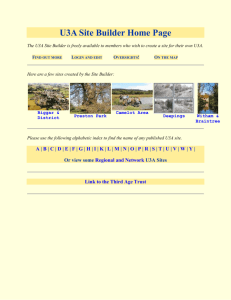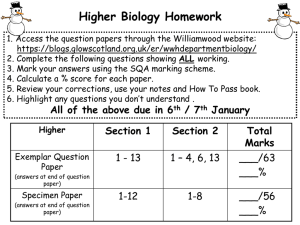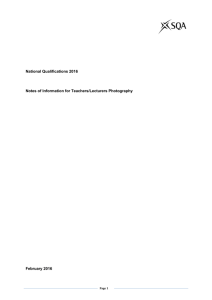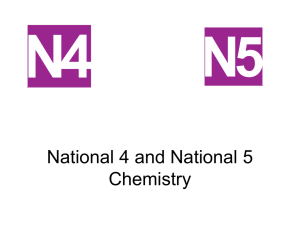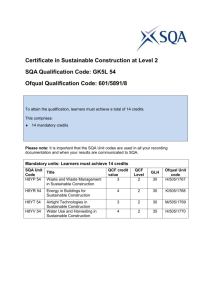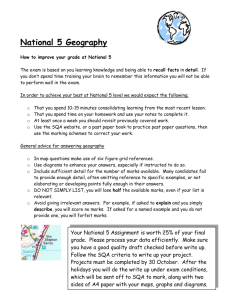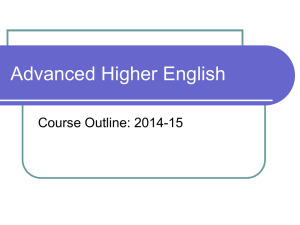Route map through learning, teaching and assessment Course: Photography
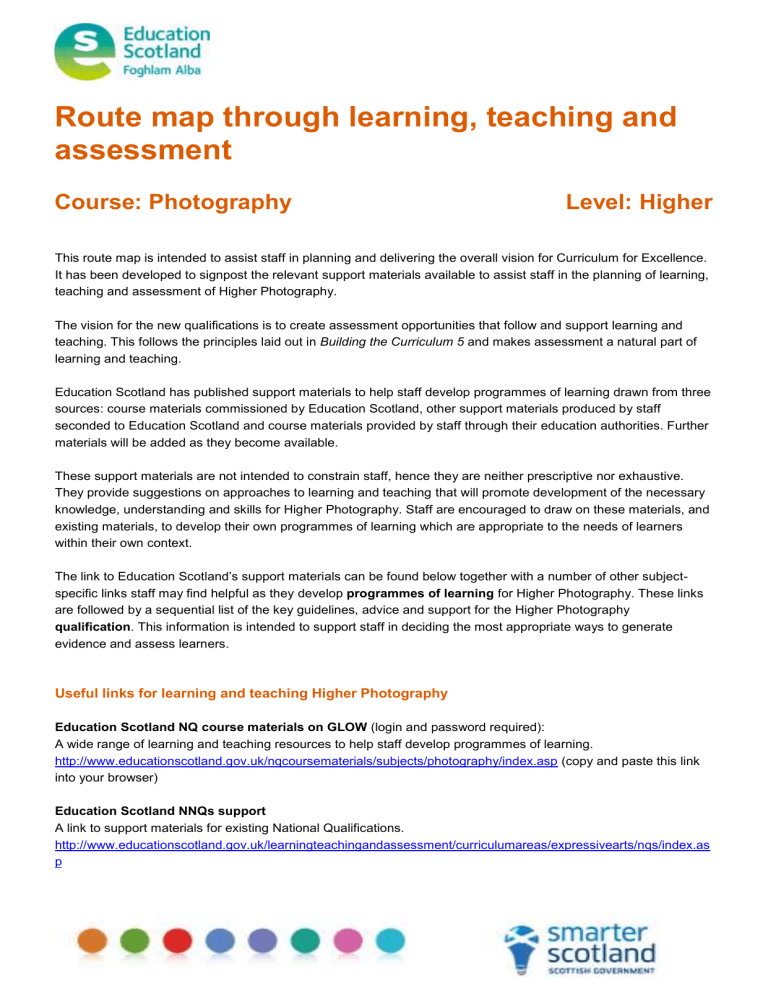
Route map through learning, teaching and assessment
Course: Photography Level: Higher
This route map is intended to assist staff in planning and delivering the overall vision for Curriculum for Excellence.
It has been developed to signpost the relevant support materials available to assist staff in the planning of learning, teaching and assessment of Higher Photography.
The vision for the new qualifications is to create assessment opportunities that follow and support learning and teaching. This follows the principles laid out in Building the Curriculum 5 and makes assessment a natural part of learning and teaching.
Education Scotland has published support materials to help staff develop programmes of learning drawn from three sources: course materials commissioned by Education Scotland, other support materials produced by staff seconded to Education Scotland and course materials provided by staff through their education authorities. Further materials will be added as they become available.
These support materials are not intended to constrain staff, hence they are neither prescriptive nor exhaustive.
They provide suggestions on approaches to learning and teaching that will promote development of the necessary knowledge, understanding and skills for Higher Photography. Staff are encouraged to draw on these materials, and existing materials, to develop their own programmes of learning which are appropriate to the needs of learners within their own context.
The link to Education Scotland’s support materials can be found below together with a number of other subjectspecific links staff may find helpful as they develop programmes of learning for Higher Photography. These links are followed by a sequential list of the key guidelines, advice and support for the Higher Photography qualification . This information is intended to support staff in deciding the most appropriate ways to generate evidence and assess learners.
Useful links for learning and teaching Higher Photography
Education Scotland NQ course materials on GLOW (login and password required):
A wide range of learning and teaching resources to help staff develop programmes of learning. http://www.educationscotland.gov.uk/nqcoursematerials/subjects/photography/index.asp
(copy and paste this link into your browser)
Education Scotland NNQs support
A link to support materials for existing National Qualifications.
http://www.educationscotland.gov.uk/learningteachingandassessment/curriculumareas/expressivearts/nqs/index.as
p
PHOTOGRAPHY
SQA course and unit support notes providing advice and guidance on learning and teaching http://www.sqa.org.uk/files_ccc/CfE_CourseUnitSupportNotes_Higher_ExpressiveArts_Photography.pdf
Key Curriculum for Excellence support
A quick guide to finding vital information about Curriculum for Excellence under the following headings:
the latest guidance, updates and plans for embedding Curriculum for Excellence
information on assessment
information on the new qualifications. http://www.educationscotland.gov.uk/keycfesupport/index.asp
National Assessment Resource (login and password required)
Materials that inform planning for learning, teaching, moderation and assessment.
https://www.narscotland.org.uk/
BBC ‘The Genius of Photography’
This website follows the story of photography through the ages. http://www.bbc.co.uk/photography/genius/
Tnrcommunications.co.uk
This website has 100 helpful photography tutorials. http://photography.tutsplus.com/articles/100-helpful-photography-tutorials-for-beginners-and-professionals--photo-
3673
Higher Photography course content
Higher Photography consists of two units and a coursework assessment.
Image Making http://www.sqa.org.uk/files_ccc/CfE_Unit_H_Photography_ImageMaking.pdf
There is a full package of unit assessment support available on the SQA Secure website for this mandatory unit.
The package includes unit assessments for both combined approaches, and also unit-by-unit approaches.
Contextual Imagery http://www.sqa.org.uk/files_ccc/CfE_Unit_H_Photography_ContextualImagery.pdf
There is a full package of unit assessment support available on the SQA Secure website for this mandatory unit.
The package includes unit assessments for both combined approaches, and also unit-by-unit approaches.
Course Assessment http://www.sqa.org.uk/files_ccc/GAInfoHigherPhotography.pdf
This document provides general assessment information for the project component of the Higher Photography course assessment.
This is a new course and no direct comparisons are available with previous courses at higher level. The course assessment evidence will be submitted to SQA for central marking.
PHOTOGRAPHY
Unit Assessment (internal)
Units are mandatory when taken as part of the full Higher Photography course but they can be standalone also.
Unit support notes follow on from the course support notes. http://www.sqa.org.uk/files_ccc/CfE_CourseUnitSupportNotes_Higher_ExpressiveArts_Photography.pdf
Requirements for the coursework assessment (project) http://www.sqa.org.uk/files_ccc/CfE_CourseAssessSpec_Higher_ExpressiveArts_Photography.pdf
The course assessment specification provides a detailed overview of the requirements for each component of the course assessment.
Project
The project is worth a total of 100 marks. This counts towards 100% of the overall course assessment. Marks will be awarded for planning, implementing and evaluating the project.
The purpose of th is project is to assess learners’ ability to integrate and develop their creativity and technical skills within a negotiated photography project.
The project is in three sections:
1. Research and investigation (25 marks)
2. Development and production (60 marks)
3. Evaluation (15 marks)
Section 1, en titled ‘Research and Investigation’, will have 25 marks.
Marking of each part of Section 1 should be approached holistically. Marks will be awarded for:
a structured project proposal, showing evidence of project planning skills (based on the negotiated photography project brief)
consideration of site logistics and resource availability during the planning process (including health and safety, access, legality and copyright issues as appropriate)
collated investigative research related to the project topic, including research and investigation of relevant image makers/photographers.
Section 2, titled ‘Development and Production’, will have 60 marks.
A maximum of 20 marks will be awarded for the exploratory development of photographic images. Marking should be approached holistically, with marks being awarded for:
the exploratory development of photographic imagery (including contact sheets or test images where appropriate)
evidence of on-going justified and creative decision making.
A further 40 marks will be awarded for further developing the exploratory ideas and producing photographic images in response to the agreed project. Marking should be approached holistically, with marks being awarded for:
the initial selection of images to meet the project requirements
producing a series of 12 technically competent images
file optimisation, production, printing and presentation of the photographic images on suitable papers/substrates
the final selection of 12 appropriate images to meet the project requirements.
PHOTOGRAPHY
Section 3, titled ‘Evaluation’, will have 15 marks.
The marks will be awarded for:
critically reflecting on and identifying personal strengths and areas for improvement in their photographic work
critically reflecting on and identifying personal strengths and areas for improvement in their practice.
Detailed marking instructions can be accessed in the ‘Photography Project Assessment Task’ document located on the SQA secure website. https://secure.sqa.org.uk/files/cfe/Photography/Higher/CATHigherPhotography.pdf
Points of change and areas of stability across National 5 and new CfE Higher are discussed in the following document: http://www.sqa.org.uk/sqa/files_ccc/H_Photography_Course_comparison.pdf
.
Verification
The verification process is intended to be supportive to practitioners.
Internal verification is the process of ensuring standards are applied uniformly and consistently within a school in line with national standards. External verification is the process of ensuring that national standards are maintained consistently across all schools and is carried out by SQA.
Information on quality assurance is available at: http://www.sqa.org.uk/sqa/58448.html
.
The following links will also support practitioners when preparing evidence for verification purposes including prior verification, as well as internal and external verification: http://www.sqa.org.uk/files_ccc/Prior%20Verification%20Centre%20Guidance%20FINAL.pdf http://www.sqa.org.uk/sqa/files_ccc/InternalVerificationGuideforSQAcentres.pdf http://www.sqa.org.uk/sqa/files_ccc/Evidence_required_for_verificationevents.pdf http://www.sqa.org.uk/sqa/files_ccc/SQA_Evidence_retention_requirements_A3_table.pdf
.
Key messages from the verification process will be posted on the SQA website.
Results services http://www.sqa.org.uk/sqa/files_ccc/FA6669_SQA_Results_Services_A5_8pp_brochure_web.pdf
http://www.sqa.org.uk/sqa/65427.html
SQA offer two services to replace the appeals process:
Exceptional Circumstances Consideration Service (details to be provided to SQA within ten days of the learner sitting the external assessment)
Post-results Service – this consists of a clerical check and/or a marking review if the centre has concerns about the results of an individual or group.
T +44 (0)141 282 5000 E enquiries@educationscotland.gov.uk W www.educationscotland.gov.uk
Education Scotland, Denholm House, Almondvale Business Park, Almondvale Way, Livingston EH54 6GA
© Crown copyright, 2012
You may re-use this information (excluding images and logos) free of charge in any format or medium, under the terms of the Open Government Licence providing that it is reproduced accurately and not in a misleading context. The material must be acknowledged as Crown copyright and the document title speci fied.
To view this licence, visit http://www.nationalarchives.gov.uk/doc/open-government-licence or e-mail: psi@nationalarchives.gsi.gov.uk
Where we have identified any third party copyright information you will need to obtain permission from the copyright holders concerned.
